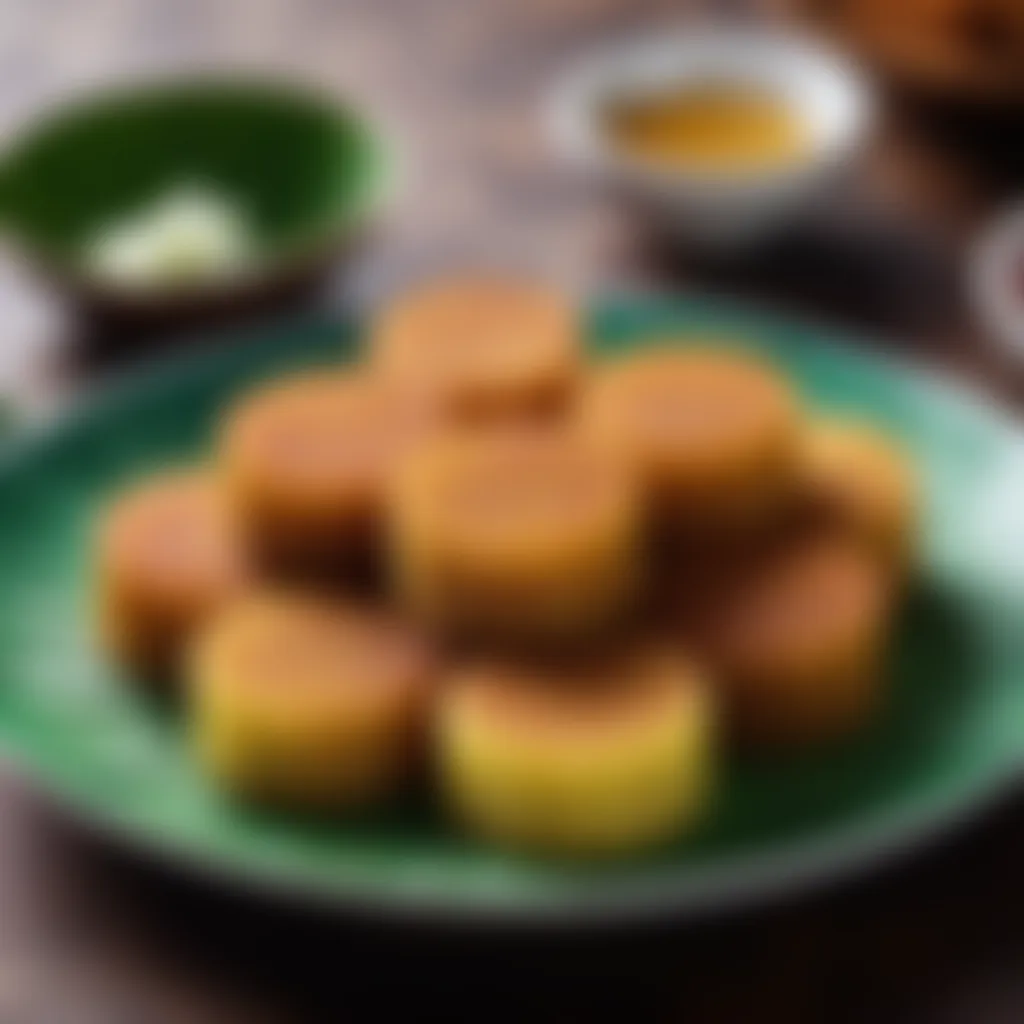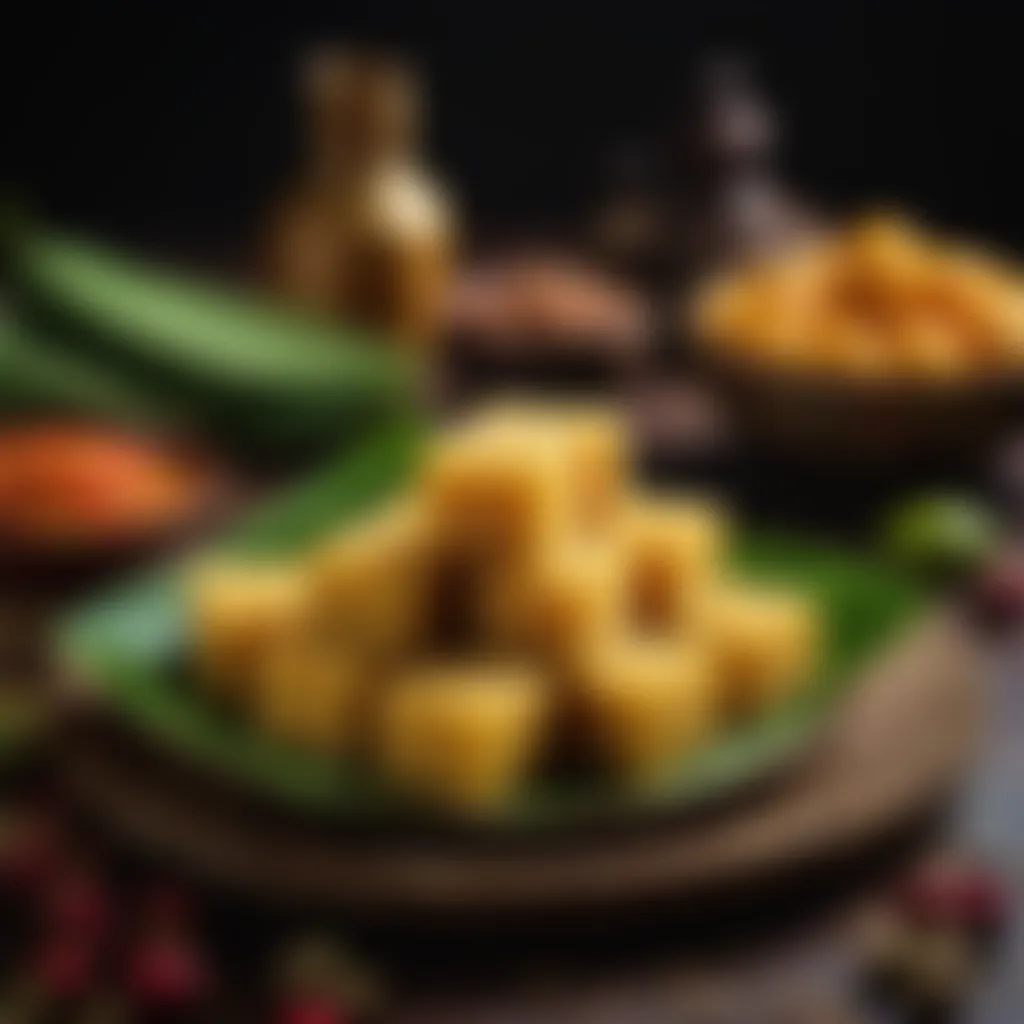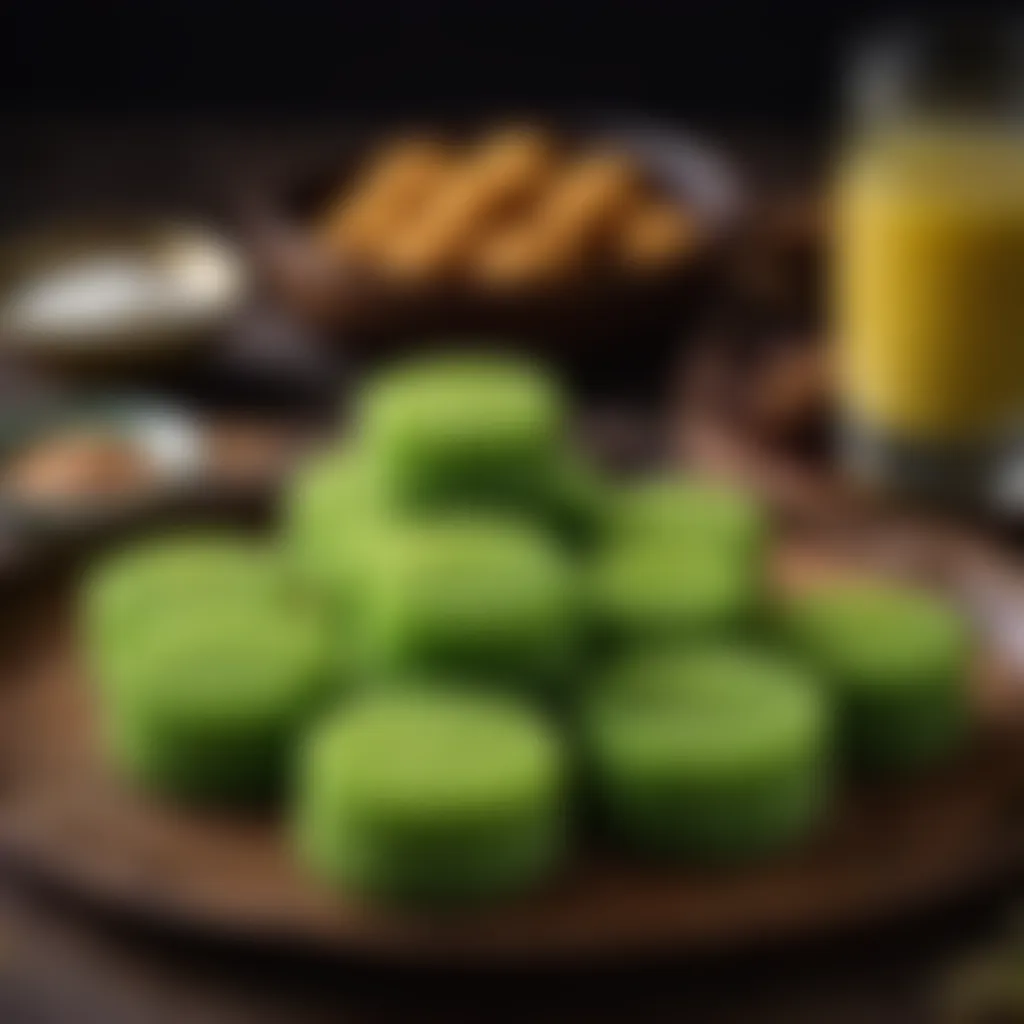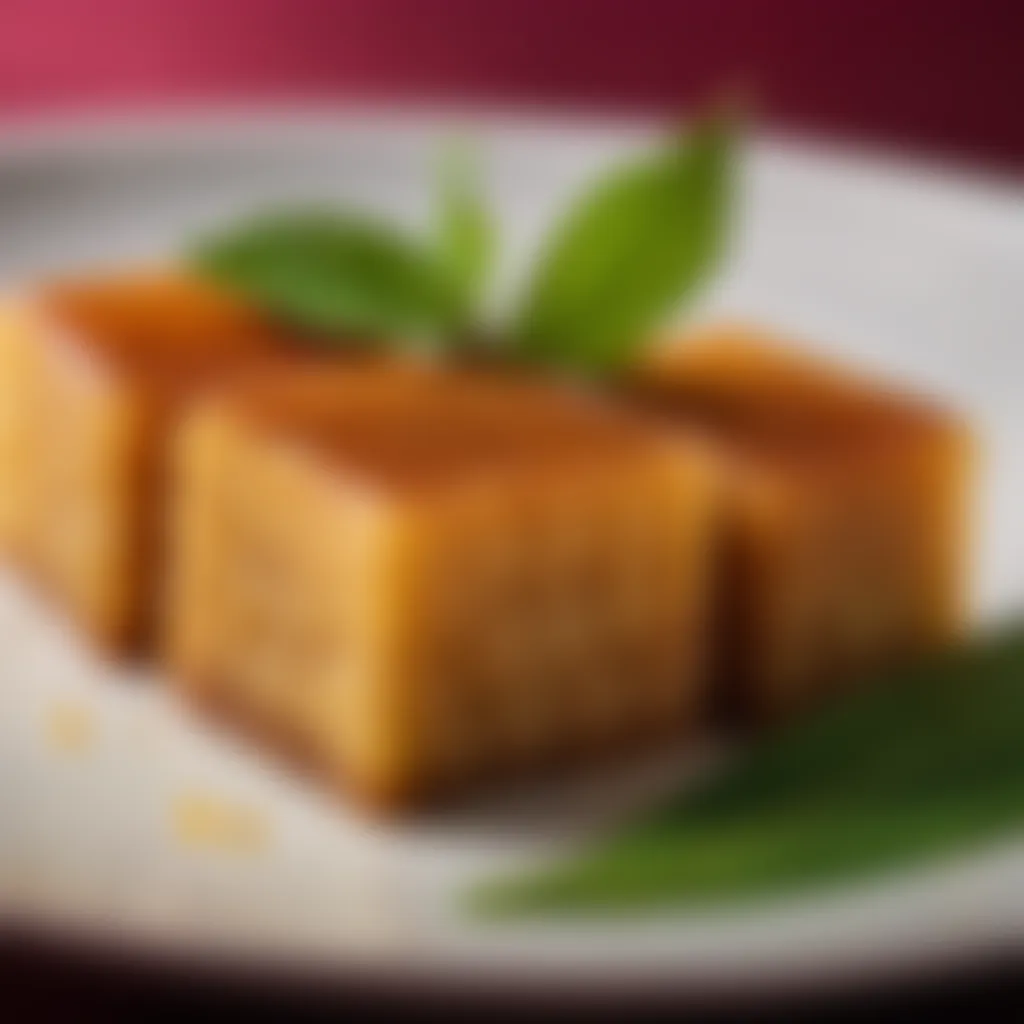The Delectable Recipe for Kuih Kaswi: A Malaysian Delight


Intro
Kuih Kaswi, a treat often associated with family gatherings and celebrations, has carved a niche in the hearts of Malaysians. This delightful dessert, with its soft and chewy texture draped in coconut and sugar, speaks volumes about traditional techniques passed down over generations. Originating from the vibrant culinary landscape of Malaysia, Kuih Kaswi is more than just a dessert; it encapsulates culture, history, and the joy of sharing.
The preparation of Kuih Kaswi is a blend of art and science, ensuring that every bite encapsulates the essence of its heritage. Each layer brings together simplicity and depth, inviting individuals to partake in a delicious experience that often sparks fond memories of home and comfort. As we delve into this rich world of flavors, let's set the stage by gathering our ingredients and stepping into the heart of this enchanting recipe.
Foreword to Kuih Kaswi
Kuih Kaswi represents not merely a dessert but a vibrant thread woven into the fabric of Malaysian culture. To appreciate this delightful treat, one must delve into its flavors, history, and the artistry behind its creation. This section lays the groundwork for the rest of the article, guiding readers through the humble yet significant role of Kuih Kaswi in Malaysian culinary traditions while sparking an interest in uncovering its secrets.
Overview of Traditional Malaysian Desserts
Traditional Malaysian desserts offer a feast for the senses. Much like a potluck, there's something to satisfy every palate. These desserts are often characterized by a medley of textures and flavors that reflect the rich multicultural heritage of Malaysia. Here’s a glimpse of what to expect:
- Diverse Ingredients: The use of rice flour, coconut milk, and pandan leaves lends these sweets a unique taste that’s both refreshing and comforting.
- Varied Preparations: From steamed cakes to fried treats, the cooking methods vary, giving each dessert its special charm.
- Occasionally Festive: Many of these desserts, including Kuih Kaswi, play prominent roles during festivals and gatherings, making them symbols of celebration and community.
Without a doubt, Kuih Kaswi fits right into this intricate tapestry, showcasing the craftsmanship of local artisans and home bakers alike, showcasing the heart of Malaysian culinary prowess.
Historical Context of Kuih Kaswi
To understand Kuih Kaswi, one must first take a stroll down memory lane. This dessert’s roots can be traced back to more simple times when using local ingredients was a way of life. The word "kuih," often used to reference traditional Malaysian cakes, embodies the essence of local culture and heritage.
Originally, the preparation of Kuih Kaswi involved methods passed down through generations. Families would gather, sharing wisdom, laughter, and stories as they created this delightful treat. Here are a few points of interest regarding its history:
- Cultural Fusion: Influences from Malay, Chinese, and Indian cooking styles are evident, illustrating Malaysia's diverse narrative.
- Celebratory Staple: Kuih Kaswi is often prepared during significant life events, from weddings to communal festivities, highlighting its importance in bringing people together.
- Adaptations Over Time: While traditional recipes remain cherished, modern interpretations have emerged that cater to current tastes and dietary preferences.
"Ultimately, Kuih Kaswi is more than just a dessert; it’s a testament to the enduring spirit of Malaysian gastronomic heritage."
As we journey further into this article, we shall explore the ingredients, preparation techniques, and the rich cultural landscape surrounding this beloved treat.
Understanding the Ingredients
Understanding the ingredients is the backbone of mastering any recipe, particularly when it comes to traditional dishes like Kuih Kaswi. Each component not only adds flavor but also plays a crucial role in the texture, appearance, and overall authenticity of the dessert. When you grasp the significance of these ingredients, it’s easier to appreciate the cultural nuances embedded in this beloved Malaysian treat.
Essential Components of Kuih Kaswi
To craft a perfect Kuih Kaswi, one needs to pay close attention to its essential components. Here are the main players:
- Rice Flour: This is the primary flour used in Kuih Kaswi, lending a delicate chewiness that defines the dish.
- Tapioca Flour: Adding tapioca flour provides a slightly sticky texture, helping the Kuih hold together when steamed.
- Coconut Sugar: This natural sweetener brings a pleasant caramel flavor that complements the coconut.
- Coconut Milk: A rich addition that not only elevates the creaminess of the cake but also enriches its aroma.
Each of these ingredients works in harmony, contributing to that unique balance of sweet, salty, and creamy flavors that Kuih Kaswi is celebrated for.
The Role of Coconut Milk


Coconut milk is more than just a supplementary ingredient; it’s a star player in the Kuih Kaswi recipe. It infuses the dessert with a rich and creamy texture, which is often the difference between a mediocre and a truly memorable bite. The full-fat kind provides depth, while also ensuring that the Kuih remains moist after steaming.
When it comes to cooking, it’s essential to choose high-quality coconut milk to get that authentic taste. You can usually find it in cans, but for a fresher approach, consider grating fresh coconuts and squeezing out the milk yourself. This can impart an even purer flavor. Plus, just a hint of salt added to the coconut milk can elevate the overall sweetness of the dish by providing contrast.
Importance of Pandan Leaves
Pandan leaves are often referred to as the "vanilla of the East" due to their heady scent and flavor. In Kuih Kaswi, they are indispensable. The leaves bring a natural green hue to the dessert, adding visual appeal as well as a fragrant floral note that elevates the overall taste experience.
When adding pandan, you would typically tie the leaves into knots and either extract the juice or infuse it in boiling water. Some home cooks even prefer using fresh leaves straight into the mix for that extra boost of aroma. Understanding how to properly incorporate pandan into Kuih Kaswi is crucial; it not only enhances flavor but also ties the dish firmly to its Malaysian roots.
A well-prepared Kuih Kaswi is a canvas where every ingredient paints a part of the Malaysian culinary story, encapsulating culture and tradition in one delightful bite.
Preparation Techniques
Understanding the various techniques used in preparing Kuih Kaswi is fundamental to achieving that perfect balance of textures and flavors which is the hallmark of this delightful treat. These steps are not merely a checklist; they reflect a beautiful synergy between tradition and skill. Embracing proper preparation techniques ensures that you not only follow a recipe but also connect with the rich cultural tapestry of Malaysian culinary heritage.
Gathering Utensils and Ingredients
Before diving into the intricacies of making Kuih Kaswi, it’s wise to prepare a well-organized workspace. This means having all the necessary utensils on hand. You will need:
- A steamer or steaming pot
- Mixing bowls
- Measuring cups and spoons
- A whisk or a spatula for mixing
- A rectangular or square cake tin for shaping the kuih
As for ingredients, they are the stars of this show. It’s essential to choose quality components for the best results. The basics include:
- Rice flour
- Tapioca flour
- Coconut milk
- Palm sugar
- Pandan leaves
- Food coloring (if desired)
Once everything is laid out, it reduces stress and allows you to focus fully on the creation process. This simple step can elevate your cooking experience significantly and prevent any last-minute scrambles which might lead to oversight or mistakes.
Step-by-Step Recipe for Kuih Kaswi
- Prepare the Steamer: Start by filling your steamer pot with water and bringing it to a gentle boil. This is the basic setup, your cooking canvas, if you will.
- Mix the Dry Ingredients: In a mixing bowl, combine rice flour and tapioca flour. Stir them well until everything's even, ensuring no lumps remain.
- Combine Coconut Milk and Sugar: Heat the coconut milk gently over low heat, then mix in the palm sugar. Stir until the sugar is completely dissolved. This combination is where the magic begins, imparting a rich flavor to the kuih.
- Incorporate the Wet and Dry Ingredients: Slowly pour the coconut milk mixture into the bowl of dry ingredients, stirring thoroughly. This process eliminates any clumps and creates a smooth batter.
- Adding Pandan Flavor: Blend in a small amount of pandan extract or juice to your batter for the signature flavor. If you’re using pandan leaves, boil them with a little water to extract their vibrant color and taste, then incorporate this into the mixture.
- Coloring the Batter (Optional): If you wish to add visual appeal, separate a small portion of the batter and mix in food coloring. Be creative, as this dish welcomes a splash of color.
- Layering the Batter: Pour about half of the batter into the greased cake tin. Steam this layer for approximately 15 minutes, until it sets. Then, add your colored batter on top and steam again until firm. Repeat this process if you want more layers.
- Cooling and Serving: Once cooked, allow it to cool completely before cutting it into squares or rectangles. It’s essential that you let it rest, as this helps in achieving the right texture.
Common Mistakes to Avoid
Navigating the path to a perfect Kuih Kaswi might come with a few bumps. Here are some common pitfalls and ways to sidestep them:
- Not Measuring Ingredients Accurately: Precision matters in baking and dessert-making. Using approximate measures can alter the balance of flavors and textures.
- Rushing the Steaming Process: Steaming takes patience. Avoid lifting the lid too frequently, as this interrupts the cooking process and can affect the final product.
- Skipping the Cooling Stage: Cutting the kuih too early can lead to a mushy texture, so holding off until it's completely cool is wise.
- Using Low-Quality Ingredients: The quality of your coconut milk and sugar directly impacts taste, so skimping here can be a big letdown.
By keeping these aspects in mind and practicing the recipes step by step, you are on your way to mastering the delightful art of making Kuih Kaswi.
Cultural Significance
Kuih Kaswi is more than just a sweet treat. It carries with it layers of meaning, serving as a bridge between past and present, rich in tradition and cultural identity. As part of Malaysia’s diverse tapestry of culinary delights, this dessert plays a crucial role not just on the dining table, but in the social fabric of Malaysian life.
Kuih Kaswi in Festivities


During important celebrations such as Hari Raya, Chinese New Year, or even local festivals, Kuih Kaswi often takes center stage. It is made with love and shared among families and friends, symbolizing unity and appreciation. When you see a platter adorned with these colorful cakes, it immediately brings a sense of joy and nostalgia, reminding many of their childhood.
In many Malaysian households, the act of preparing Kuih Kaswi is a family affair. Adults and children alike gather in the kitchen, each contributing in their own way. This process not only strengthens bonds but also passes down knowledge and traditional practices from one generation to the next. Here, the creation of this delicacy transforms into an enjoyable ritual of togetherness, embodying the spirit of sharing.
"Food is not just about sustenance; it's about the connection and stories behind it."
Role in Malaysian Culinary Heritage
Kuih Kaswi represents a fundamental piece of the Malaysian culinary puzzle, seamlessly blending various cultural influences. It's a testament to how different ethnicities in the country have come together, resulting in unique flavors and cooking techniques. It reflects the harmony among the Malay, Chinese, and Indian communities in Malaysia.
Moreover, this dessert showcases the typical use of local ingredients like pandan leaves and coconut milk, which are staples in Malaysia's agricultural landscape. Every bite of Kuih Kaswi carries the essence of the land, reinforcing the importance of local produce and traditional cooking methods.
It's intriguing to note that while Kuih Kaswi has evolved over the years, its roots remain firmly planted in the traditions of Malaysian society. The nuanced flavors and textures continue to endear it to enthusiasts across generations. This dessert stands as a vessel of cultural storytelling, illustrating the customs, festivities, and shared memories of the Malaysian way of life.
Variations of Kuih Kaswi
Exploring the variations of Kuih Kaswi is not just an academic pursuit; it provides a flavorful insight into the rich culinary landscape of Malaysia. With each region boasting its unique twist on this dessert, such variations offer a glimpse into local traditions and flavors that can define a kitchen. This section dives into both the regional differences and the innovative spins on Kuih Kaswi that have emerged in modern cuisine.
Regional Differences in Recipes
In Malaysia, geographical diversity leads to variations that reflect local tastes, ingredients, and cultural influences. Different states may prepare Kuih Kaswi in distinct ways, keeping the spirit of the dish alive while introducing distinctive characteristics.
- Southern Sabah Style: In this region, the use of a higher percentage of grated coconut is common. This gives the dessert a denser texture and a more pronounced coconut flavor, which many locals love.
- Penang’s Flavors: Here, you might find the addition of other natural sweeteners, like gula Melaka, which can lend a richer brown tone and molasses flavor different from the standard white sugar.
- Kedah’s Creativity: Known for innovation, some Kedah locals may sprinkle a bit of ground nuts on top before steaming, adding a delightful crunch that contrasts beautifully with the soft texture of Kuih Kaswi.
These regional adaptations underscore how Kuih Kaswi is not merely a singular entity but a canvas for creativity. Each bite transports the taster to a different part of Malaysia, making it a true national treasure.
Innovations in Modern Cuisine
While the traditional recipe holds a special place in hearts, the evolution of Kuih Kaswi has ushered in some modern twists that appeal to contemporary taste buds. Innovation doesn’t mean losing the essence; rather, it adds layers to the narrative of this beloved dessert.
- Novel Ingredients: Nowadays, health-conscious cooks might swap out the refined sugar for organic versions, or even experiment with coconut sugar, which is touted for its lower glycemic index. This makes Kuih Kaswi not just a treat, but a more health-friendly dessert.
- Vegan Versions: With the rise of plant-based diets, some have begun to replace traditional ingredients like eggs or dairy with alternatives like almond milk or flaxseed meal. The result can be just as satisfying and maintains the spirit of the traditional dessert.
- Fusion Cuisine: Entering the world of fusion, some chefs are daring enough to infuse tropical fruit purees like mango or lychee into the batter. This experimentation opens up new flavor profiles that are radically different from the classic version.
The continual adaptation of Kuih Kaswi showcases its versatility and its ability to resonate with newer generations while still appealing to traditionalists. As a comforting sweet that bridges generations and tastes, these variations ensure that Kuih Kaswi remains at the forefront in any culinary discussion about Malaysia's desserts.
"Tradition is a guide and not a jailer" – this philosophy rings true for Kuih Kaswi, as it evolves while staying rooted in its beloved history.
Serving Suggestions
Serving suggestions play a crucial role in how Kuih Kaswi is appreciated, lifting its presentation and boosting the overall eating experience. It’s not just about putting the dish on the table; it’s about how you create a memory for those involved. By pairing it with the right accompaniments and presenting it thoughtfully, you elevate this traditional treat from a simple dessert to a centerpiece that can ignite conversations and elicit nostalgic memories.
Pairing with Accompaniments
When it comes to enjoying Kuih Kaswi, the right accompaniments can do wonders. Traditionally, this delightful dessert is enjoyed with a variety of items that can bring out its flavors and enhance the dining experience. Here are some pairings that can reflect both cultural significance and personal preference:


- Coconut Cream: Drizzling warm or cold coconut cream on top of Kuih Kaswi adds a luxurious, creamy texture that complements the moistness of the cake. This combination is rich and satisfying.
- Sesame Seeds: A sprinkle of toasted sesame seeds can add a delightful nutty crunch. Their earthy flavor balances the sweetness of the dessert quite well.
- Palm Sugar Syrup: A light drizzle of palm sugar syrup can amplify the sweetness, providing a syrupy contrast that enriches every bite.
- Fresh Fruits: Pair it with sliced mango or ripe bananas for a fresh, fruity contrast that can lighten the overall flavor.
Remember, these accompaniments not only highlight the flavors of Kuih Kaswi but also allow for some creativity and personalization. Experimenting with different pairings can lead to delightful discoveries.
Presentation Ideas
Presentation can make or break the experience when serving Kuih Kaswi at home or during a gathering. A bit of thoughtfulness in how you serve this delightful dish can elevate it significantly and show that you care about your guests' experience. Here are a few simple yet elegant ideas:
- Plate it with Style: Use a beautiful ceramic plate with intricate designs. The contrast between the green of the pandan coloring and the texture of the plate can be stunning.
- Garnish with Edible Flowers: Adding a few edible flowers alongside the cake not only adds color but also makes the dish look fancy and inviting.
- Use Banana Leaves for Authentic Appeal: Serving the Kuih Kaswi on a piece of banana leaf not only looks stunning but also adds a subtle aroma that enhances the dessert.
- Create a Minimalist Setup: Sometimes less is more. A simple wooden board with a few slices of Kuih Kaswi placed artfully can speak volumes. Just a minimalist presentation garnished with a light dusting of icing sugar can make a great impression.
By integrating different elements from these presentation ideas and pairing suggestions, you can create a feast for the eyes that complements the exquisite flavors of Kuih Kaswi. This attention to detail will invite guests not just to eat, but to savor every moment spent sharing a slice of this delightful traditional dessert.
Nutrition and Health Aspects
When delving into the world of Kuih Kaswi, it's essential to understand more than just its delicious taste and texture. The nutritional value of this delightful dessert not only contributes to its appeal but also taps into some important health aspects, making it a worthy treat to include in your occasional sweet indulgences. Let's break it down into specific points to get a clearer picture.
Nutritional Value of Kuih Kaswi
Kuih Kaswi, generally made from rice flour, coconut milk, and sugar, presents some key nutritional elements. Each component contributes its share of goodness:
- Rice Flour: This staple provides carbohydrates, which serve as an energy source. It's also lower in calories compared to regular flour and is gluten-free, making it suitable for those with dietary restrictions.
- Coconut Milk: Rich in vitamins C, E, and various B vitamins, this ingredient adds creaminess while packing some nutritional benefits. It contains medium-chain triglycerides (MCTs), which have been associated with various health benefits, such as improved gut health and potential weight management.
- Sugar: While it provides sweetness, moderation is key. The amount can be adjusted depending on personal taste preferences. Just keep in mind that excessive sugar consumption may have adverse health effects.
- Pandan Leaves: Often infused into the mix for flavor and color, pandan leaves contain antioxidants that can help in reducing inflammation and boosting overall health.
In terms of caloric density, a small piece of Kuih Kaswi generally has around 100-150 calories, which might not seem much if enjoyed occasionally. However, always keep track of portion sizes, especially if it's served alongside other treats.
Health Considerations
When enjoying Kuih Kaswi, it’s sensible to keep in mind various health considerations:
- Balance is Key: While it may be tempting to indulge in these flavorful squares, maintaining a balanced diet is crucial. Pair Kuih Kaswi with fresh fruits or even a cup of unsweetened tea to round out the experience nutritionally.
- Mindful Eating: Since desserts can trigger cravings, practicing mindful eating can benefit your overall approach to sweets. Savor each bite, allowing yourself to truly enjoy the flavors rather than consuming out of habit.
- Sugar Intake Awareness: Be conscious of the daily sugar intake recommendations—generally not exceeding 6 teaspoons for women and 9 teaspoons for men. Adjustments in your Kuih recipe can help align with these guidelines, for instance, by using natural sweeteners instead of refined sugar.
- Potential Allergies: Always consider allergies or intolerances within your household. Gluten-free and dairy-free alternatives can be explored, ensuring the dessert remains inclusive for all.
Takeaway: Understanding the nutritional value and health aspects of Kuih Kaswi can enrich your experience with this delightful dessert. It offers a glimpse into not just taste but also health awareness, making each serving just that more satisfying.
Closure
The exploration of Kuih Kaswi not only highlights its culinary artistry but also serves as a testament to the rich tapestry of Malaysian culture. This conclusion brings together various threads of discussion, weaving through the history, significance, and gastronomic allure of this traditional dessert.
The Enduring Appeal of Kuih Kaswi
The charm of Kuih Kaswi lies deeply rooted in its flavors and textures, as well as its emotional resonance with many. Its distinctive aroma, which wafts through kitchens, transports individuals to their childhood memories—perhaps a time when a grandparent would lovingly prepare this treat. Beyond mere taste, it embodies the warmth of gatherings, often shared during festivals or family events. This dessert is more than just a meal; it is a carrier of stories, traditions, and the spirit of community.
The lush green of pandan leaves melds seamlessly with the creamy richness of coconut milk, creating a unique palate experience. Every bite of Kuih Kaswi encapsulates the artistry involved from understanding the ingredients to perfecting the preparation techniques, appealing to both nostalgic sentiments and modern culinary curiosity.
"Food is not just fuel; it's information. It talks to your DNA and tells you what you should be doing." – Dr. Vincent Pedre
Encouragement to Explore Traditional Recipes
Encouraging readers to dabble in traditional recipes like Kuih Kaswi can open avenues to uncovering culinary heritage. Experimenting with these recipes provides an opportunity to connect with one's roots, fostering an appreciation for the techniques and stories behind each dish. Cooking isn't always about following a strict cookbook; it's about embracing creativity and adding personal flair.
As the world leans into evolving culinary trends, traditional recipes like Kuih Kaswi deserve a spot in modern kitchens. They offer a chance to honor the past while simultaneously inviting innovation. Engaging with such recipes can serve to educate not only the cook but also the family members who taste the results, sparking conversations about heritage and history around the dinner table.
In summation, exploring Kuih Kaswi and other traditional dishes is an invitation to a journey—a beautiful blend of taste, culture, and memory, waiting to be shared with loved ones.







